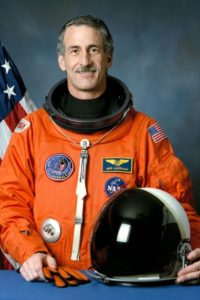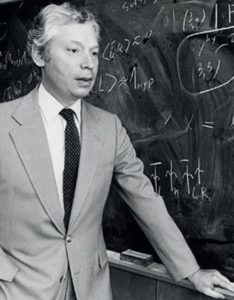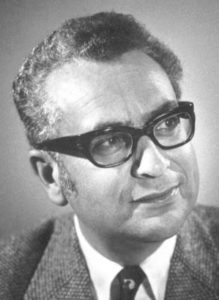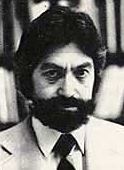NASA’s First Jewish Astronaut
 Jeffrey Alan Hoffman (b. 1944) was born in Brooklyn. He was always fascinated by outer space, and went to study astronomy at Amherst College in Massachusetts. Hoffman went on to get a PhD in astrophysics from Harvard, researching cosmic x-rays and gamma rays. He built one of the first aerial gamma ray telescopes. After this, he did postdoctoral work in the UK, eventually working as a project scientist for the European Space Agency. In 1975, Hoffman returned to the US to work at MIT. His main area of focus was x-ray bursts, and he authored over 20 papers on the subject, becoming the world expert on it. One time, he heard his wife reading a passage in a book saying that there will never be a Jewish astronaut. This inspired Hoffman to pursue just that, and he applied to NASA. In 1978, he was selected for NASA’s astronaut training program, together with Judith Resnik. The two became NASA’s first Jewish astronauts. Hoffman went on his first mission in 1985 aboard the Space Shuttle Discovery, during which the crew deployed two satellites and conducted numerous scientific experiments. At this point, Hoffman became just the second Jewish man in space (following Russian cosmonaut Boris Volynov). During his fourth trip to space, Hoffman was responsible for repairing the Hubble Space Telescope. Before that flight, his rabbi asked him if he would take some Judaica with him, and Hoffman happily agreed. He took a mezuzah—which he affixed to his cabin with Velcro—a tallit, as well as a dreidel and mobile menorah, since it was during Chanukah. (Click here to see Hoffman spin a dreidel in space!) On another flight, Hoffman took a Torah with him and made sure to read it while flying over Jerusalem. During his last mission in 1996, Hoffman set a new record, becoming the first astronaut to spend 1000 hours aboard space shuttles. All in all, he spent more than 50 days in space, and logged over 21 million space miles travelled. Since retiring as an astronaut, he has been teaching as a professor at MIT, and visiting professor at the University of Leicester. He has also written a book called An Astronaut’s Diary.
Jeffrey Alan Hoffman (b. 1944) was born in Brooklyn. He was always fascinated by outer space, and went to study astronomy at Amherst College in Massachusetts. Hoffman went on to get a PhD in astrophysics from Harvard, researching cosmic x-rays and gamma rays. He built one of the first aerial gamma ray telescopes. After this, he did postdoctoral work in the UK, eventually working as a project scientist for the European Space Agency. In 1975, Hoffman returned to the US to work at MIT. His main area of focus was x-ray bursts, and he authored over 20 papers on the subject, becoming the world expert on it. One time, he heard his wife reading a passage in a book saying that there will never be a Jewish astronaut. This inspired Hoffman to pursue just that, and he applied to NASA. In 1978, he was selected for NASA’s astronaut training program, together with Judith Resnik. The two became NASA’s first Jewish astronauts. Hoffman went on his first mission in 1985 aboard the Space Shuttle Discovery, during which the crew deployed two satellites and conducted numerous scientific experiments. At this point, Hoffman became just the second Jewish man in space (following Russian cosmonaut Boris Volynov). During his fourth trip to space, Hoffman was responsible for repairing the Hubble Space Telescope. Before that flight, his rabbi asked him if he would take some Judaica with him, and Hoffman happily agreed. He took a mezuzah—which he affixed to his cabin with Velcro—a tallit, as well as a dreidel and mobile menorah, since it was during Chanukah. (Click here to see Hoffman spin a dreidel in space!) On another flight, Hoffman took a Torah with him and made sure to read it while flying over Jerusalem. During his last mission in 1996, Hoffman set a new record, becoming the first astronaut to spend 1000 hours aboard space shuttles. All in all, he spent more than 50 days in space, and logged over 21 million space miles travelled. Since retiring as an astronaut, he has been teaching as a professor at MIT, and visiting professor at the University of Leicester. He has also written a book called An Astronaut’s Diary.
When Jews and Greeks Were Brothers: The Untold Story of Chanukah
Words of the Week
…Science can only be created by those who are thoroughly imbued with the aspiration toward truth and understanding. This source of feeling, however, springs from the sphere of religion.
– Albert Einstein



